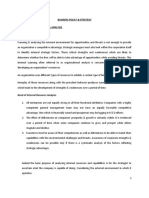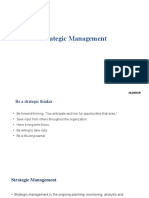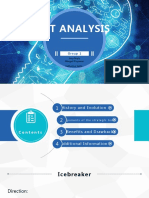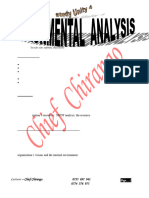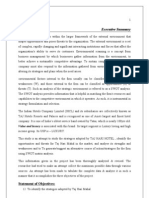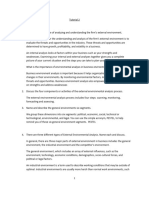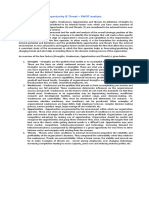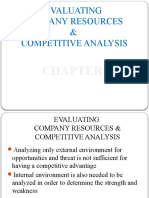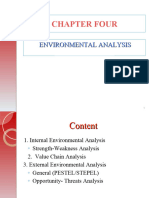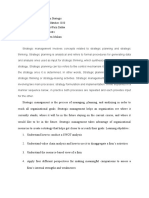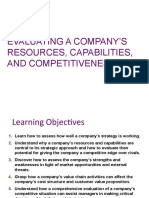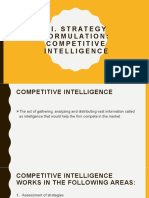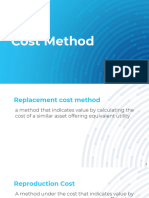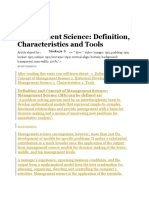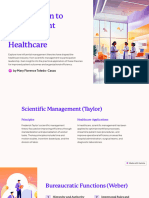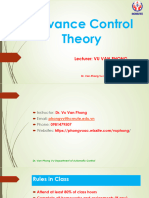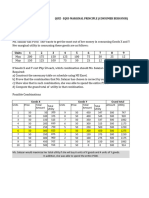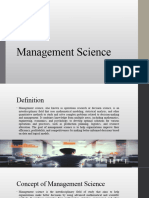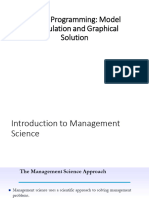Strat Lec 3
Strat Lec 3
Uploaded by
CIELO VERL GASATANCopyright:
Available Formats
Strat Lec 3
Strat Lec 3
Uploaded by
CIELO VERL GASATANOriginal Title
Copyright
Available Formats
Share this document
Did you find this document useful?
Is this content inappropriate?
Copyright:
Available Formats
Strat Lec 3
Strat Lec 3
Uploaded by
CIELO VERL GASATANCopyright:
Available Formats
Lecture on Internal Environmental
Analysis in Strategic Management
1. Introduction to Internal Environmental Analysis
2. Assessing Organizational Resources and Capabilities
3. Core Competencies and Competitive Advantage
4. Conducting SWOT Analysis
1. Introduction to Internal Environmental Analysis
What is Internal Environmental Analysis?
In simple terms, internal environmental analysis is the process of examining a company's
assets, processes, people, and capabilities. It's like taking a 'health check' of what the firm
has at its disposal to compete effectively.
Why is it Important?
1. Identifies Strengths and Weaknesses: Helps to pinpoint what a company does well
and where it falls short.
2. Informs Strategy: Provides the data that informs your broader business strategy.
3. Uncovers Opportunities: May uncover latent potential within the organization.
2. Assessing Organizational Resources and Capabilities
Organizational Resources
1. Physical Resources: Buildings, machines, equipment.
2. Human Resources: Skills, knowledge, and abilities of employees.
3. Financial Resources: Capital, cash flow, financial reserves.
4. Intangible Resources: Brand, patents, reputation.
Capabilities
Capabilities refer to the company’s ability to utilize resources effectively. For example:
● Efficient manufacturing processes
● Stellar customer service
● Robust supply chain management
Assessing Resources and Capabilities
1. Resource Audit: Inventory of resources.
2. Benchmarking: Compare with competitors and industry standards.
3. Balanced Scorecard: Look at metrics from multiple dimensions, including financial
and non-financial aspects.
3. Core Competencies and Competitive Advantage
What are Core Competencies?
Core competencies are unique capabilities that confer competitive advantages. These are
the things that a company does exceptionally well and are hard for competitors to
replicate.
Characteristics of Core Competencies
1. Valuable: Adds value to the product or service.
2. Rare: Not commonly found in the industry.
3. Inimitable: Difficult for competitors to imitate.
4. Non-substitutable: Cannot be easily replaced.
Competitive Advantage through Core Competencies
● Cost Leadership: Doing the same things as competitors but at a lower cost.
● Differentiation: Offering unique attributes that are valued by customers.
4. Conducting SWOT Analysis
What is SWOT?
SWOT stands for Strengths, Weaknesses, Opportunities, and Threats. This tool can help
summarize key points from your internal and external analysis.
Internal Factors in SWOT
1. Strengths: Internal resources and capabilities that can be used as a basis for
developing a competitive advantage.
2. Weaknesses: Internal limitations that may interfere with a company's ability to
achieve its objectives.
How to Conduct a SWOT Analysis?
1. List the Factors: Openly list down strengths and weaknesses.
2. Prioritize: Not all factors are equally important.
3. Strategies: Use strengths to capitalize on opportunities and mitigate threats. Work
on weaknesses to prepare for external challenges.
Summary
● Internal Environmental Analysis is critical for understanding what a firm has at its
disposal for competitive positioning.
● Resources and capabilities set the foundation, but it’s the core competencies that
provide a true competitive edge.
● SWOT analysis serves as a synthesis tool, bringing together internal and external
analysis to guide strategic decision-making.
You might also like
- Applied Economics: Q2: Week 1-2: Module 1Document21 pagesApplied Economics: Q2: Week 1-2: Module 1Godwill Oliva88% (16)
- Chapter 4. Internal AssessmentDocument19 pagesChapter 4. Internal AssessmentLouciaNo ratings yet
- Strategic Management ProcessDocument3 pagesStrategic Management ProcessMae Ann DioNo ratings yet
- Week 4 Internal AnalysisDocument21 pagesWeek 4 Internal AnalysisdionirtaNo ratings yet
- 04 - Company's Internal AnalysisDocument36 pages04 - Company's Internal AnalysisJohnny RamonNo ratings yet
- Chapter 3Document42 pagesChapter 3project manajement2013No ratings yet
- SM - 4Document56 pagesSM - 4Abel RonaldoNo ratings yet
- Ch-4Document15 pagesCh-4barnatade1234No ratings yet
- Methods of Analyzing Internal RevenueDocument15 pagesMethods of Analyzing Internal RevenueCassia ィNo ratings yet
- Analyzing The Internal Environment and Establishing Lond-Range ObjectivesDocument30 pagesAnalyzing The Internal Environment and Establishing Lond-Range ObjectivesNahian HasanNo ratings yet
- Company Situation AnalysisDocument18 pagesCompany Situation AnalysisShah Maqsumul Masrur TanviNo ratings yet
- Chapter 5 THE INTERNAL ENVIRONMENT ANALYSISDocument6 pagesChapter 5 THE INTERNAL ENVIRONMENT ANALYSISkfbrillantes16No ratings yet
- Lecture 4-Strategic ManagementDocument26 pagesLecture 4-Strategic ManagementOmar ElkadyNo ratings yet
- Chapter 5Document19 pagesChapter 5Rochelle Esquivel ManaloNo ratings yet
- Strategic Managemetn Lecture 8Document3 pagesStrategic Managemetn Lecture 8rabia khanNo ratings yet
- Lecture 6 Module 3.2Document18 pagesLecture 6 Module 3.2Kanza NaeemNo ratings yet
- Internal AnalysisDocument35 pagesInternal AnalysisMargaretta LiangNo ratings yet
- Mgt703 Strategic Management Tutorial 2 (B) The Internal EnvironmentDocument8 pagesMgt703 Strategic Management Tutorial 2 (B) The Internal EnvironmentKrishneel Anand PrasadNo ratings yet
- STRAMA Chapter 4 1Document12 pagesSTRAMA Chapter 4 1CIARA MAE ORTIZNo ratings yet
- 4 Internal AssesmentDocument37 pages4 Internal AssesmentUmair AbbasNo ratings yet
- SM - Notes 3Document12 pagesSM - Notes 3TC26COUNSELNo ratings yet
- Strategic Management - 1Document40 pagesStrategic Management - 1Milind B JoshiNo ratings yet
- SWOT ANALYSIS PPT TempDocument31 pagesSWOT ANALYSIS PPT TempAira Austria NialaNo ratings yet
- Internal Environment Analysis: Prepared By: Limheya Lester Glenn R PCU-MBA ProgramDocument35 pagesInternal Environment Analysis: Prepared By: Limheya Lester Glenn R PCU-MBA ProgramXXXXXXXXXXXXXXXXXXNo ratings yet
- Organisation Theory, Structure and DesignDocument14 pagesOrganisation Theory, Structure and DesignManinder KaurNo ratings yet
- Econ SWOT AnalysisDocument20 pagesEcon SWOT AnalysisCastor DamasoNo ratings yet
- BM303 - Chapter 4 - Internal Environmental AnalysisDocument14 pagesBM303 - Chapter 4 - Internal Environmental AnalysisNessa NessaNo ratings yet
- Case QSTNZDocument22 pagesCase QSTNZAli0% (1)
- EDE2Document9 pagesEDE2YOGESH CREATION 143No ratings yet
- SM ProjectDocument61 pagesSM Projectpreeti_bph74467% (3)
- Organisational AppraisalDocument20 pagesOrganisational AppraisalVinay Sharma100% (6)
- Strategy Management U123 NotesDocument7 pagesStrategy Management U123 NotesAdarsh DashNo ratings yet
- Unit 04 PDFDocument18 pagesUnit 04 PDFgrandoverallNo ratings yet
- SM Note (AutoRecovered)Document21 pagesSM Note (AutoRecovered)yordanosgetahun887No ratings yet
- Topic 3-S-MKTDocument30 pagesTopic 3-S-MKTeliza ChaleNo ratings yet
- Internal AnalysisDocument3 pagesInternal AnalysisRashmi SainiNo ratings yet
- 4 Internal AnalysisDocument23 pages4 Internal AnalysisPrateek Vatsa MishraNo ratings yet
- MGT703 Topic 2 TutorialDocument3 pagesMGT703 Topic 2 TutorialDeepashni DeviNo ratings yet
- Strategic Intent and Environmental AppraisalDocument31 pagesStrategic Intent and Environmental AppraisalAshika MehtaNo ratings yet
- SLHT - Applied Economics Week3 Q2 With Page NumberDocument10 pagesSLHT - Applied Economics Week3 Q2 With Page NumberPëàrl Ragasajo100% (1)
- A6 UNIT 3 Lecture 6 Internal EnvironmentDocument34 pagesA6 UNIT 3 Lecture 6 Internal EnvironmentjeresandrakNo ratings yet
- Strength Weakness Opportunity & Threat - SWOT AnalysisDocument3 pagesStrength Weakness Opportunity & Threat - SWOT AnalysisSurabhi Kapadekar100% (3)
- KWUDocument23 pagesKWUMardiahNo ratings yet
- Chapter 5Document24 pagesChapter 5Roshani ShresthaNo ratings yet
- 4 PSDM RBVDocument6 pages4 PSDM RBVSiti Nurul DarasaNo ratings yet
- Chapter 4Document46 pagesChapter 4asterayemetsihet87No ratings yet
- Technology and Livelihood Education 8 Environment and MarketDocument8 pagesTechnology and Livelihood Education 8 Environment and MarketLorie BraciaNo ratings yet
- Lecture On SWOT AnalysisDocument32 pagesLecture On SWOT AnalysisDasarathan Rajaraman100% (1)
- Unit-4Document41 pagesUnit-4Karan EvangelineNo ratings yet
- Mata Kuliah: Manajemen Strategis Hari/tgl: Sabtu, 31 Oktober 2020 Nama: Muhammad Firzi ZalikaDocument4 pagesMata Kuliah: Manajemen Strategis Hari/tgl: Sabtu, 31 Oktober 2020 Nama: Muhammad Firzi ZalikaIzz IzzNo ratings yet
- Chapter 5 EditedDocument32 pagesChapter 5 Editedshirleygebenga020829No ratings yet
- Unit IV Assessing The INTERNAL Environment of An OrganizationDocument44 pagesUnit IV Assessing The INTERNAL Environment of An Organizationmacs emsNo ratings yet
- CH 4Document35 pagesCH 4RajatNo ratings yet
- Introduction of The Topic: SWOT Analysis (Alternatively SWOT Matrix) Is An Acronym For Strengths, WeaknessDocument59 pagesIntroduction of The Topic: SWOT Analysis (Alternatively SWOT Matrix) Is An Acronym For Strengths, WeaknessStarNo ratings yet
- Internal AnalysisDocument12 pagesInternal AnalysisKirabo Ivy MarthaNo ratings yet
- What Are The Steps To Perform A Strategic Analysis?Document3 pagesWhat Are The Steps To Perform A Strategic Analysis?Fathi FathuNo ratings yet
- 4 TH SemDocument63 pages4 TH SemSamina ksNo ratings yet
- III. & IV. Competitive Intelligence-Internal AuditDocument23 pagesIII. & IV. Competitive Intelligence-Internal AuditGeraldine Mae DamoslogNo ratings yet
- Environment Analysis: Session - 2Document34 pagesEnvironment Analysis: Session - 2ThamaliNo ratings yet
- EVALUATING THE ROLE OF CORE COMPETENCIES IN IMPROVING PERFORMANCE OF MANUFACTURING INDUSTRIESFrom EverandEVALUATING THE ROLE OF CORE COMPETENCIES IN IMPROVING PERFORMANCE OF MANUFACTURING INDUSTRIESNo ratings yet
- 24 March Payout Calculator The Marigold ProjectDocument138 pages24 March Payout Calculator The Marigold ProjectCIELO VERL GASATANNo ratings yet
- Cost Method - FINMAN4 For UploadDocument25 pagesCost Method - FINMAN4 For UploadCIELO VERL GASATANNo ratings yet
- PROBLEMS Chap 5Document8 pagesPROBLEMS Chap 5CIELO VERL GASATANNo ratings yet
- Sanchez Rape CaseDocument3 pagesSanchez Rape CaseCIELO VERL GASATANNo ratings yet
- Mind Map Spex2Document2 pagesMind Map Spex2Nurul HudaeniNo ratings yet
- TO Management ScienceDocument9 pagesTO Management ScienceZein GonzalezNo ratings yet
- TamrinDocument7 pagesTamrintriziounNo ratings yet
- Management Science 1234Document10 pagesManagement Science 1234Joy PlacidoNo ratings yet
- Chapter 7 - The Theory of Demand - The Utility Approach-1Document19 pagesChapter 7 - The Theory of Demand - The Utility Approach-1bongiwemadonsela956No ratings yet
- Concept of Utility PPT 16Document1 pageConcept of Utility PPT 16Chloe Erin BernardoNo ratings yet
- الاستراتيجية و الثقافة التنظيميةDocument17 pagesالاستراتيجية و الثقافة التنظيميةNadir BonnoisNo ratings yet
- MARKETINGDocument10 pagesMARKETINGTAOUI SAIDNo ratings yet
- 9112 - JIT and Backflush CostingDocument2 pages9112 - JIT and Backflush CostingCelestaire LeeNo ratings yet
- Introduction To Management Theories in HealthcareDocument10 pagesIntroduction To Management Theories in HealthcaremfqtoledoNo ratings yet
- Mentes, Máquinas y Matemáticas. La Inteligencia Artificial y Sus Retos - Ignasi BeldaDocument150 pagesMentes, Máquinas y Matemáticas. La Inteligencia Artificial y Sus Retos - Ignasi BeldaProgramación EFPNo ratings yet
- Day 2 - People Analytics - KelasHR - AnungDocument36 pagesDay 2 - People Analytics - KelasHR - AnungteguhNo ratings yet
- CRM Data SheetDocument1 pageCRM Data SheetDBIRI YoussefNo ratings yet
- Assignment Two Last - RegDocument3 pagesAssignment Two Last - RegSolomon LemaNo ratings yet
- Chapter 2 - Sliding Mode ControlDocument30 pagesChapter 2 - Sliding Mode Controldtran2354No ratings yet
- Work Breakdown Structure WBSDocument7 pagesWork Breakdown Structure WBSramadansaidinNo ratings yet
- Management Science: (Prepared by MS. ARMI K. BUYCO, CPA, MBA)Document3 pagesManagement Science: (Prepared by MS. ARMI K. BUYCO, CPA, MBA)KA TENo ratings yet
- QUIZ Equi Marginal PrincipleDocument4 pagesQUIZ Equi Marginal Principlenisha danielNo ratings yet
- QUestion Bank CHapter 7 and 8Document4 pagesQUestion Bank CHapter 7 and 8en.jordannaNo ratings yet
- Final Exam Schedule 2013 EntryDocument10 pagesFinal Exam Schedule 2013 Entrysemetegna she zemen 8ተኛው ሺ zemen ዘመንNo ratings yet
- 02 Lesson 1 - Introduction To Management ScienceDocument16 pages02 Lesson 1 - Introduction To Management ScienceHoney MayNo ratings yet
- FOURTEEN Theories of ManagementDocument16 pagesFOURTEEN Theories of Managementkingokoro777No ratings yet
- EVM Practice In-Class ExercisesDocument6 pagesEVM Practice In-Class Exercisesrawn34No ratings yet
- Engineering Applications of Operations ResearchDocument29 pagesEngineering Applications of Operations Researchcalev28828No ratings yet
- AzmexDocument33 pagesAzmexMaህNo ratings yet
- 5-N-Strategic LSCM Configuration-BkelDocument16 pages5-N-Strategic LSCM Configuration-BkelHẠNH PHẠM HIẾUNo ratings yet
- Management ScienceDocument12 pagesManagement ScienceLinaNo ratings yet
- Interactive Study Plan APM - CleanedDocument94 pagesInteractive Study Plan APM - Cleanedtshepiso.namosheNo ratings yet
- Management Science - Is A Scientific Approach ToDocument3 pagesManagement Science - Is A Scientific Approach ToChard PintNo ratings yet
- Linear ProgrammingDocument42 pagesLinear ProgrammingDimas Fajri PamungkasNo ratings yet




















